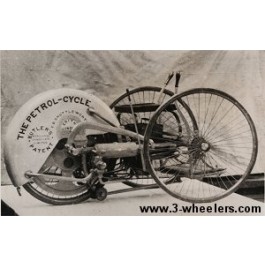The Butler Petrol Cycle is accepted by many as the very first British motor car although as it never went into production many other people class Henry Knight’s 3-wheeler as the first British motor car. Although Karl Benz is recognised as the inventor of the modern motor car an Englishman named Edward Butler was said to have exhibited plans for a 3-wheeled vehicle two years earlier than Benz in 1884 at the Stanley Cycle Show, London (UK) and it was also the first design shown at the 1885 Inventions Exhibition, London (UK)
Butler however did not patent (Patent 15598 - London) his vehicle until 1887 due to British laws on experiments. On the vehicle the patent read “Butlers Petrol-Cycle Syndicate Limited Patent”. It also referred to “F.B. Shuttleworth, Erith, London.” as Butler built the Petrol Cycle in the works of F.B. Shuttleworth. In 1890 Butler finished his design which was a vehicle powered by an engine that used mineral hydro-carbons.
The two-cylinder engine worked by a spray of Benzoline or petroleum product carburetted with air. The configuration saw two 32 inch wheels at the front which steered the vehicle. This was done by a pair of rocking handles actuating the front wheels which moved on separate pivots. A single rear wheel was powered by a chain whilst a single saddle type seat was positioned in between the front two wheels. A braking device was attached to both front wheels and activated by a foot lever.
Butler refined the vehicle further by using a four stroke water cooled engine that achieved 600 rpm. He is credited with first using the word “Petrol” and inventing the spark plug, magneto, coil ignition and spray jet carburettor. Butler found problems with his invention due to government restrictions and on the 12th December 1890 whilst referencing his vehicle wrote the following in the English Mechanic journal;
“..the authorities do not countenance its use on the roads, and I have abandoned in consequence any further development of it.
At the time the maximum speed was 2 mph in the city and 4 mph in the country side. In addition each vehicle had to be attended by 3 people of which one had to walk in front of the vehicle waving a red flag (The 1865 Red Flag Act) to warn other road users and help control horses. This act had originally appeared as a result of the growing number of steam powered vehicles.
You can see how restrictive this speed limit was for Butler from an article on the Butler Petrol Cycle in the February 14th 1891 edition of the Scientific American. This stated that one gallon of petroleum or benzolene was enough to “furnish sufficient power” to achieve a journey of forty miles at a speed ranging from 3 - 10 mph. The speed of the vehicle was regulated by a throttle valve lever whilst over heating was prevented by water circulating through a radiator over the rear driving wheel.
Stopping and starting the vehicle was managed by raising and lowering the driving wheel from the ground by a foot lever, the weight of the vehicle was then spread onto two small castor wheels ahead of the driving wheel.
In 1900 Butler penned a letter to “The Autocar” magazine of which they published on April 7th 1900. The letter read:
“Now that public attention is being drawn to the early attempts of the two German pioneers, Benz and Daimler, I trust that you may find space in your journal for an illustration (Second image on this page) of a small petrol vehicle, which I believe was absolutely the first made in this country, and if I could have interested any one to finance it when the drawings were exhibited at the Stanley Show in 1884, and the following year at the Inventions Exhibition, I should have been contemporaneous, if not earlier than either of them.
Although I cannot claim to have done very much in the light of the present enormous development of the automotor trade, it may have been forgotten that I carried out a series of experiments in the perfecting of a motor vehicle at a time when progress was much hindered by the prejudice and want of interest - the motor part of which has been since used in many types of engines for industrial purposes
Butler then went on to describe his latest development of an 80 hp vertical compound three cylinder engine standing at seven feet six inches and weighing six and a half tons
Due to the lack of interest, Butler broke his Petrol Cycle up for scrap in 1896 where upon the patent rights were sold to H.J. Lawson and the engine continued to be produced for motor boats. Shortly afterwards the Locomotive on Highways Act of 1896 was passed that allowed speeds of up to 14 mph. This resulted in an immense change that saw new factories being established and motoring within the UK moving on rapidly







